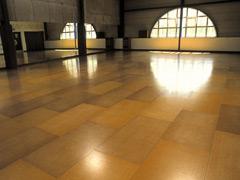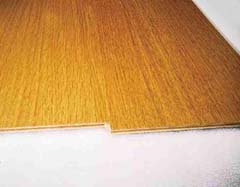|
MDF is used widely for the construction of new floors and the refurbishments of existing floors to take advantage of its inherent flatness and only small movement in response to changes in ambient conditions.
MDF sheets, 18 to 22 mm thickness, can be used for the construction of raised floors on beams as an alternative to solid wood strips or particleboard. They can be used for floating floors fixed to wood supporting strips laid over a concrete base or on an existing floor which is uneven or has become damaged. A water vapour barrier should be laid below the MDF to minimise any increases in moisture content and consequent bowing.
In each of these constructions, the floors can be built up from large panels or tongue and grooved strips, typically 1200 mm x 300 mm x 18 mm, which can easily be cut on site to fit in difficult corners or round apertures. Flooring strips are easily transported and can be fitted in confined spaces, in alcoves or lofts, for instance. But jointed edges should always be supported by beams or battens. Joints should be staggered for additional strength.
Untreated strips of MDF are hard wearing with high impact resistance. Appearance can however be improved by finishing with polyurethane varnish or paint or surfacing with lino or PVC tiles. Alternatively, the surfaces of the MDF can be veneered with selected hardwoods to create a parquet or wood block effect.
MDF has been used successfully for the manufacture of 600mm x 600mm panels for platform access flooring often fitted in new buildings to allow quick access to underfloor services. The high stability of MDF and its high strength are advantageous for this application.
Although standard grade MDF can he used for most flooring applications, the enhanced properties of moisture resistant and high density grades have advantages for more critical applications. Note should also be taken of national regulations which may require the use of low formaldehyde materials.
|
 |
|














